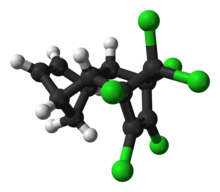ആൾഡ്രിൻ
രാസസംയുക്തം
ആൾഡ്രിൻ ഒരു ഓർഗാനോക്ലോറിൻ കീടനാശിനിയാകുന്നു. 1970ൽ അതിന്റെ നിരോധനം വരെ ലോകവ്യാപകമായി ഉപയോഗിച്ചിരുന്നു. അത് നിറമില്ലാത്ത ഖരവസ്തുവാണ്. നിരോധനസമയം വരെ വിത്തിലും മണ്ണിലും ഇത് വളരെയധികം ഉപയോഗിച്ചുവന്നു. കൂടുതൽ കാലം നിലനിൽക്കുന്ന സൈക്ലോഡീൻ പ്രകൃതിക മലിനീകാരിയായി കുപ്രസിദ്ധമാണ്.

| |

| |
| Names | |
|---|---|
| IUPAC names
1,2,3,4,10,10-Hexachloro-
1,4,4a,5,8,8a-hexahydro- 1,4:5,8-dimethanonaphthalene | |
| Other names | |
| Identifiers | |
3D model (JSmol)
|
|
| ChemSpider | |
| ECHA InfoCard | 100.005.652 |
| KEGG | |
| UNII | |
CompTox Dashboard (EPA)
|
|
| InChI | |
| SMILES | |
| Properties | |
| തന്മാത്രാ വാക്യം | |
| Molar mass | 0 g mol−1 |
| Appearance | colorless solid |
| സാന്ദ്രത | 1.60 g/mm3[1] |
| ദ്രവണാങ്കം | |
| slightly soluble (0.003%)[1] | |
| ബാഷ്പമർദ്ദം | 7.5 × 10−5 mmHg @ 20 °C |
| Hazards | |
| Main hazards | potential occupational carcinogen[1] |
| Flash point | {{{value}}} |
| Lethal dose or concentration (LD, LC): | |
LD50 (median dose)
|
50 mg/kg (rabbit, oral) 33 mg/kg (guinea pig, oral) 39 mg/kg (rat, oral) 44 mg/kg (mouse, oral)[2] |
LCLo (lowest published)
|
5.8 mg/m3 (rat, 4 hr)[2] |
| NIOSH (US health exposure limits): | |
PEL (Permissible)
|
TWA 0.25 mg/m3 [skin][1] |
REL (Recommended)
|
Ca TWA 0.25 mg/m3 [skin][1] |
IDLH (Immediate danger)
|
25 mg/m3[1] |
Except where otherwise noted, data are given for materials in their standard state (at 25 °C [77 °F], 100 kPa).
| |
അവലംബം
തിരുത്തുക- ↑ 1.0 1.1 1.2 1.3 1.4 1.5 1.6 1.7 "NIOSH Pocket Guide to Chemical Hazards #0016". National Institute for Occupational Safety and Health (NIOSH).
- ↑ 2.0 2.1 "Aldrin". Immediately Dangerous to Life and Health. National Institute for Occupational Safety and Health (NIOSH).